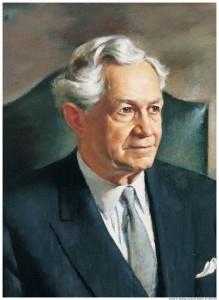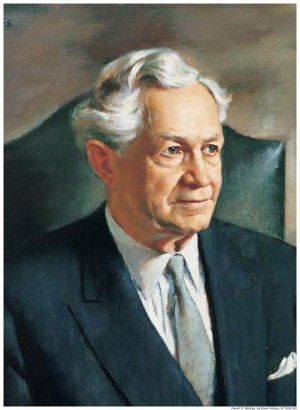David Oman McKay : The Ninth President of the Mormon Church
David Oman McKay was born in Huntsville, Utah, on September 8, 1873, to David McKay and Jeannette Evans McKay. David O., as he would be known, was born when Brigham Young was President of The Church of Jesus Christ of Latter-day Saints. David O. was privileged to be born in a time when the gospel of Jesus Christ flourished and when much of the persecution that plagued the early Mormon Church had ceased.
 The McKays originated in northern Scotland, where David’s grandparents joined the Mormon Church. Their conversion to the Church was unwavering in that they demonstrated by example the importance of the gospel in their lives and in their children’s lives. Later in life, David O. would say, “The older I grow the more grateful I am for my parents, for how they lived the gospel in that old country home…Both father and mother lived the gospel…That testimony began…in the home in my youth because of the example of a father who honored the Priesthood and his wife, who sustained him and lived it in the home.”1
The McKays originated in northern Scotland, where David’s grandparents joined the Mormon Church. Their conversion to the Church was unwavering in that they demonstrated by example the importance of the gospel in their lives and in their children’s lives. Later in life, David O. would say, “The older I grow the more grateful I am for my parents, for how they lived the gospel in that old country home…Both father and mother lived the gospel…That testimony began…in the home in my youth because of the example of a father who honored the Priesthood and his wife, who sustained him and lived it in the home.”1
Childhood
David’s parents would prove early in his life both their endurance and their testimony of obedience to whatever the Lord required. When David was a young boy, his two older sisters died within four days of each other. Within a year of these tragic deaths, the Prophet called their father on a mission to his native land of Scotland, and his mother was expecting a baby. David’s father did not want to go and leave his family in these conditions, but Sister McKay insisted that her husband go and serve the Lord. She and her son, David O., would be fine and do whatever needed to be done in his absence. Ten days after her husband left, Sister McKay gave birth to a baby girl. During his father’s absence, David O. worked hard to fulfill all the responsibilities that lay before him due to his father’s absence, including all the farm work. These circumstances helped to generate a maturity in David O. far beyond his physical years.
From the time he was little, David O. always believed in the truth and reality of the Prophet Joseph Smith and the visions which the Prophet saw. He declared later in life, “…My testimony of the reality of the existence of God dates back to that home when I was a child, and it was through [my parents’] teachings and their examples that I received then the knowledge of the reality of the spiritual world; and I testify that it is a reality.”1 Shortly before his fourteenth birthday, David O. would receive his patriarchal blessing. In it he was told, “Thou art in thy youth and need instruction, therefore I say unto thee, be taught of thy parents the way of life and salvation, that at an early day you may be prepared for a responsible position, for the eye of the Lord is upon thee…The Lord has a work for thee to do, in which thou shalt see much of the world, assist in gathering scattered Israel and also labor in the ministry. It shall be thy lot to sit in council with thy brethren and preside among the people and exhort the Saints to faithfulness.”2
College
David O.’s mother received a small inheritance, which was sufficient to send her children to school. David O. McKay chose to attend the University of Utah, where he planned to study to become a teacher. During his years at the university, he played on the football team, was valedictorian of his graduating class, played piano in a musical group, and was on the debate team. It was here that a certain young lady by the name of Emma Ray Riggs caught his eye. He looked to his future with joy and anticipation of teaching and spending life with Emma. However, the Lord had another plan at the moment. At the age of twenty-three, David O. received a call to serve a mission in the same area in which his father was called to serve—the Scottish Mission. David O. accepted this call with a determination to do as the Lord asked. This mission would be where his greatest spiritual growth would occur, and it would prepare him for future calls as a servant of the Lord.
Mission
While serving in Scotland, David O. had an experience that would stay with him for the remainder of his life. He and his companion had been in the town of Stirling for a few weeks, but had had little success. On one particular day as they were walking around and feeling rather homesick, the following experience took place. “As we returned to the town, I saw an unfinished building standing back from the sidewalk several yards. Over the front door was a stone arch, something unusual in a residence, and what was still more unusual, I could see from the sidewalk that there was an inscription chiseled in that arch. I said to my companion, ‘ That’s unusual! I am going to see what the inscription is.’ When I approached near enough, this message came to me, not only in stone, but as if it came from One in whose service we were engaged: ‘Whate’er Thou Art, Act Well Thy Part.’ I turned and walked thoughtfully away, and when I reached my companion I repeated the message to him. That was a message to me that morning to act my part well as a missionary of The Church of Jesus Christ of Latter-day Saints. It is merely another way of saying, ‘…Not every one that saith unto me, Lord, Lord, shall enter into the kingdom of heaven, but he that doeth the will of my Father which is in heaven.'”3 This event made such an impact on David O. that he resolved that very day to do all in his power to be a committed missionary in all his acts, thoughts, and deeds.
Family Life
Upon returning home from his mission in 1901, he married his beloved Emma in the Salt Lake City Temple. They would enjoy sixty-nine years together and be blessed with seven children. Over the years, David O. set the example of how to treat a woman, and he emphasized the importance of the family in our society. “One of our most precious possessions is our families. The domestic relations precede, and, in our present existence, are worth more than all other social ties. They give the first throb to the heart and unseal the deep fountains of its love. Home is the chief school of human virtues. Its responsibilities, joys, sorrow, smiles, tears, hopes, and solicitudes form the chief interests of human life…When one puts business or pleasure above his home, he that moment starts on the downgrade to soul-weakness…No other success can compensate for failure in the home…In the light of scripture, ancient and modern, we are justified in concluding that Christ’s ideal pertaining to marriage is the unbroken home.”4
Church Leadership and Service
In 1916, at the age of thirty-two, David O. was called by the Prophet Joseph F. Smith to serve as a member of the Quorum of the Twelve Apostles. He would hold this calling for more than half a century. His education as an educator served him well in the years ahead. He was called on immediately to serve as a counselor in the general Church Sunday School and became Church Commissioner of Education in 1919. He proclaimed many times that teaching was the highest of the professions. In 1920, he represented the Church on a world tour where he visited the Orient and New Zealand, during which he dedicated the land of China for the preaching of the Gospel.
In 1934, President Heber J. Grant called Elder McKay (elder being his priesthood title) to serve as one of his counselors in the First Presidency. Elder McKay would later serve as a counselor to President George Albert Smith. In 1951 after the death of President Smith, David O. McKay was sustained as the ninth president of The Church of Jesus Christ of Latter-day Saints. In his opening remarks, President McKay stated, “…I pledge to you that I shall do my best so to live as to merit the companionship of the Holy Spirit, and pray here in your presence that my counselors and I may indeed be ‘partakers of the divine spirit.'”5
Soon after being called as President of the Mormon Church, President McKay set out on a tour of the missions around the world. He traveled over a million miles proclaiming the gospel to all and encouraging the members to be missionaries in their own areas. Where previous members were encouraged to come to the ‘Land of Zion’, they were now admonished to stay in their own countries and strengthen the Church through their examples and missionary work. Thousands of Church buildings were constructed during his presidency along with several temples. There were five temples built during President McKay’s administration, with two being in the foreign lands of Switzerland and New Zealand.
President McKay not only taught how to live a Christ-like life, but he lived one himself every day. Those who would meet him, whether they were members of the Church or world leaders, each left his presence wanting to improve his or her own life. President McKay taught the importance of this concept: “An upright character is the result only of continued effort and right thinking, the effect of long-cherished associations with Godlike thoughts. He approaches nearest the Christ spirit who makes God the center of his thoughts, and he who can say in his heart, ‘Not my will, but thine be done,’ approaches most nearly the Christ ideal. Every man and every person who lives in this world wields an influence, whether for good or for evil. It is not what he says alone, it is not alone what he does. It is what he is. Every man, every person radiates what he or she is…”6
Death
On January 8, 1970, President David Oman McKay passed away, leaving many to mourn his death. For many Mormons, he had been the only Prophet they had ever known, with his service of nineteen years as Prophet, Seer, and Revelator of The Church of Jesus Christ of Latter-day Saints. Succeeding President Joseph Fielding Smith stated, “If ever a man of modern history left his world better for having lived in it, that man was David Oman McKay. Wherever he passed, men lifted their heads with more hope and courage. Wherever his voice was heard, there followed greater kindness among men, greater tolerance, and greater love. Wherever his influence was felt, man and God became closer in purpose and in action…he became one of the greatest and most inspired leaders of this dispensation…”7
1 “Presidents of the Church”, 2003, p. 147.
2 “Presidents of the Church”, 2003, p.146.
3 “Presidents of the Church”, 2003, p. 147-148.
4 “Conference Report”, Apr 1964, p.5.
5 “Conference Report”, Apr 1951, p. 157.
6 “Conference Report”, Apr 1963, p.129.
7 “One Who Loved His Fellowmen”, Improvement Era, Feb. 1970, P.87-88.
Twitter •


 Watch a video about the restoration of the gospel on lds.org
Watch a video about the restoration of the gospel on lds.org